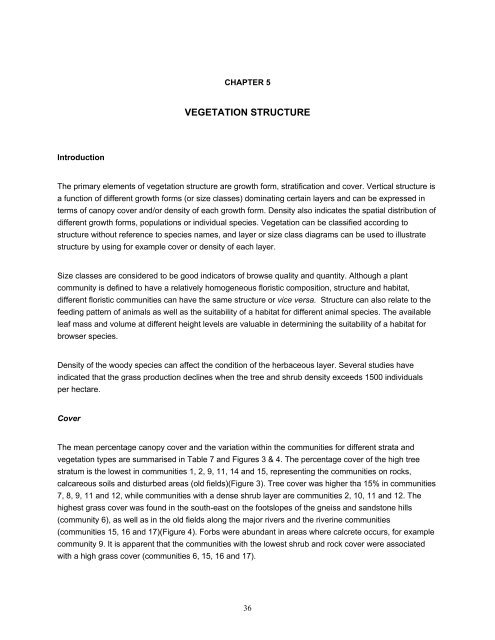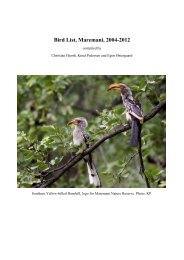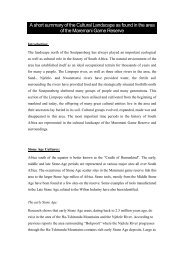the vegetation types and veld condition - Maremani Nature Reserve
the vegetation types and veld condition - Maremani Nature Reserve
the vegetation types and veld condition - Maremani Nature Reserve
You also want an ePaper? Increase the reach of your titles
YUMPU automatically turns print PDFs into web optimized ePapers that Google loves.
Introduction<br />
CHAPTER 5<br />
VEGETATION STRUCTURE<br />
The primary elements of <strong>vegetation</strong> structure are growth form, stratification <strong>and</strong> cover. Vertical structure is<br />
a function of different growth forms (or size classes) dominating certain layers <strong>and</strong> can be expressed in<br />
terms of canopy cover <strong>and</strong>/or density of each growth form. Density also indicates <strong>the</strong> spatial distribution of<br />
different growth forms, populations or individual species. Vegetation can be classified according to<br />
structure without reference to species names, <strong>and</strong> layer or size class diagrams can be used to illustrate<br />
structure by using for example cover or density of each layer.<br />
Size classes are considered to be good indicators of browse quality <strong>and</strong> quantity. Although a plant<br />
community is defined to have a relatively homogeneous floristic composition, structure <strong>and</strong> habitat,<br />
different floristic communities can have <strong>the</strong> same structure or vice versa. Structure can also relate to <strong>the</strong><br />
feeding pattern of animals as well as <strong>the</strong> suitability of a habitat for different animal species. The available<br />
leaf mass <strong>and</strong> volume at different height levels are valuable in determining <strong>the</strong> suitability of a habitat for<br />
browser species.<br />
Density of <strong>the</strong> woody species can affect <strong>the</strong> <strong>condition</strong> of <strong>the</strong> herbaceous layer. Several studies have<br />
indicated that <strong>the</strong> grass production declines when <strong>the</strong> tree <strong>and</strong> shrub density exceeds 1500 individuals<br />
per hectare.<br />
Cover<br />
The mean percentage canopy cover <strong>and</strong> <strong>the</strong> variation within <strong>the</strong> communities for different strata <strong>and</strong><br />
<strong>vegetation</strong> <strong>types</strong> are summarised in Table 7 <strong>and</strong> Figures 3 & 4. The percentage cover of <strong>the</strong> high tree<br />
stratum is <strong>the</strong> lowest in communities 1, 2, 9, 11, 14 <strong>and</strong> 15, representing <strong>the</strong> communities on rocks,<br />
calcareous soils <strong>and</strong> disturbed areas (old fields)(Figure 3). Tree cover was higher tha 15% in communities<br />
7, 8, 9, 11 <strong>and</strong> 12, while communities with a dense shrub layer are communities 2, 10, 11 <strong>and</strong> 12. The<br />
highest grass cover was found in <strong>the</strong> south-east on <strong>the</strong> footslopes of <strong>the</strong> gneiss <strong>and</strong> s<strong>and</strong>stone hills<br />
(community 6), as well as in <strong>the</strong> old fields along <strong>the</strong> major rivers <strong>and</strong> <strong>the</strong> riverine communities<br />
(communities 15, 16 <strong>and</strong> 17)(Figure 4). Forbs were abundant in areas where calcrete occurs, for example<br />
community 9. It is apparent that <strong>the</strong> communities with <strong>the</strong> lowest shrub <strong>and</strong> rock cover were associated<br />
with a high grass cover (communities 6, 15, 16 <strong>and</strong> 17).<br />
36




